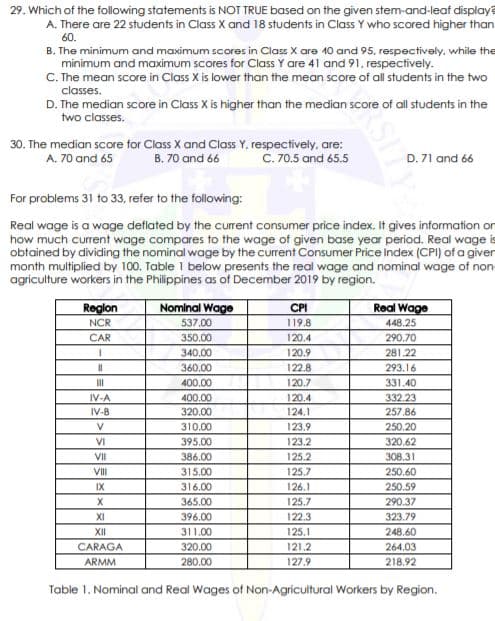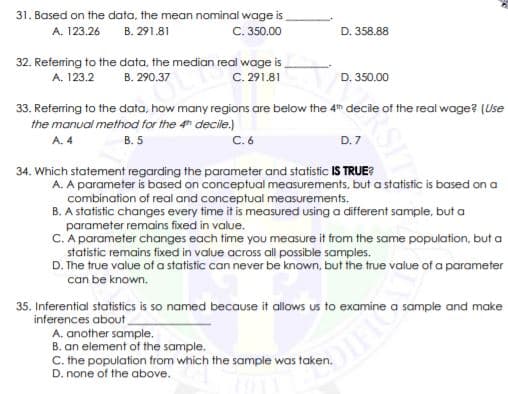31. Based on the data, the mean nominal wage is C. 350.00 A. 123.26 B. 291.81 D. 358.88 32. Referring to the data, the median real wage is B. 290.37 C. 291.81 A. 123.2 D. 350.00 33. Referring to the data, how many regions are below the 4th decile of the real wage? (Use the manual method for the 4 decile.) B. 5 C. 6 A.4 D.7 34. Which statement regarding the parameter and statistic IS TRUE? A. A parameter is based on conceptual measurements, but a statistic is based ona combination of real and conceptual measurements. B. A statistic changes every time it is measured using a different sample, but a parameter remains fixed in value. C.A parameter changes each time you measure it from the same population, but a statistic remains fixed in value across all possible samples. D. The true value of a statistic can never be known, but the true value of a parameter can be known.
31. Based on the data, the mean nominal wage is C. 350.00 A. 123.26 B. 291.81 D. 358.88 32. Referring to the data, the median real wage is B. 290.37 C. 291.81 A. 123.2 D. 350.00 33. Referring to the data, how many regions are below the 4th decile of the real wage? (Use the manual method for the 4 decile.) B. 5 C. 6 A.4 D.7 34. Which statement regarding the parameter and statistic IS TRUE? A. A parameter is based on conceptual measurements, but a statistic is based ona combination of real and conceptual measurements. B. A statistic changes every time it is measured using a different sample, but a parameter remains fixed in value. C.A parameter changes each time you measure it from the same population, but a statistic remains fixed in value across all possible samples. D. The true value of a statistic can never be known, but the true value of a parameter can be known.
Glencoe Algebra 1, Student Edition, 9780079039897, 0079039898, 2018
18th Edition
ISBN:9780079039897
Author:Carter
Publisher:Carter
Chapter10: Statistics
Section10.3: Measures Of Spread
Problem 26PFA
Related questions
Question

Transcribed Image Text:29. Which of the following statements is NOT TRUE based on the given stem-and-leaf displaya
A. There are 22 students in Class X and 18 students in Class Y who scored higher than
60.
B. The minimum and maximum scores in Class X are 40 and 95, respectively, while the
minimum and maximum scores for Class Y are 41 and 91, respectively.
C. The mean score in Class X is lower than the mean score of all students in the two
classes.
D. The median score in Class X is higher than the median score of all students in the
two classes.
30. The median score for Class X and Class Y, respectively, are:
B. 70 and 66
C. 70.5 and 65.5
A. 70 and 65
D. 71 and 66
For problems 31 to 33, refer to the following:
Real wage is a wage deflated by the current consumer price index. It gives information on
how much current wage compares to the wage of given base year period. Real wage is
obtained by dividing the nominal wage by the current Consumer Price Index (CPI) of a giver
month multiplied by 100. Table 1 below presents the real wage and nominal wage of non
agriculture workers in the Philippines as of December 2019 by region.
Reglon
Real Wage
Nominal Wage
537.00
CPI
NCR
119.8
448.25
CAR
350.00
120.4
290.70
340,00
120.9
281.22
360.00
122.8
293.16
II
400.00
120.7
331.40
IV-A
400.00
120.4
332.23
IV-B
320.00
124.1
257.86
V
310.00
123.9
250.20
VI
395.00
123.2
320.62
VII
386.00
125.2
308.31
VII
315.00
125.7
250.60
IX
316.00
126.1
250.59
365.00
125.7
290.37
XI
396.00
122.3
323.79
XII
311.00
125.1
248.60
CARAGA
320.00
121.2
264.03
ARMM
280.00
127.9
218.92
Table 1. Nominal and Real Wages of Non-Agricultural Workers by Region.

Transcribed Image Text:31. Based on the data, the mean nominal wage is
A. 123.26
C. 350.00
B. 291.81
D. 358.88
32. Referring to the data, the median real wage is
B. 290.37
A. 123.2
C. 291.81
D. 350.00
33. Referring to the data, how many regions are below the 4m decile of the real wage? (Use
the manual method for the 4 decile.)
В. 5
C. 6
D. 7
A. 4
34. Which statement regarding the parameter and statistic IS TRUE?
A. A parameter is based on conceptual measurements, but a statistic is based on a
combination of real and conceptual measurements.
B. A statistic changes every time it is measured using a different sample, but a
parameter remains fixed in value.
C. A parameter changes each time you measure it from the same population, but a
statistic remains fixed in value across all possible samples.
D. The true value of a statistic can never be known, but the true value of a parameter
can be known.
35. Inferential statistics is so named because it allows us to examine a sample and make
inferences about,
A. another sample.
B. an element of the sample.
C. the population from which the sample was taken
D. none of the above.
Expert Solution
This question has been solved!
Explore an expertly crafted, step-by-step solution for a thorough understanding of key concepts.
This is a popular solution!
Trending now
This is a popular solution!
Step by step
Solved in 2 steps

Recommended textbooks for you

Glencoe Algebra 1, Student Edition, 9780079039897…
Algebra
ISBN:
9780079039897
Author:
Carter
Publisher:
McGraw Hill

Glencoe Algebra 1, Student Edition, 9780079039897…
Algebra
ISBN:
9780079039897
Author:
Carter
Publisher:
McGraw Hill